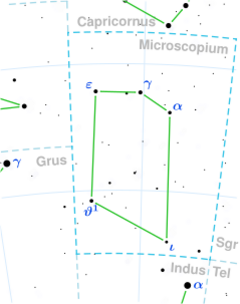Astronomy:HD 201852
| Observation data Epoch J2000.0 Equinox (celestial coordinates) | |
|---|---|
| Constellation | Microscopium |
| Right ascension | 21h 13m 18.96155s[1] |
| Declination | −36° 25′ 24.7016″[1] |
| Apparent magnitude (V) | 5.95±0.01[2] |
| Characteristics | |
| Spectral type | K0 III[3] |
| U−B color index | +0.74[4] |
| B−V color index | +0.98[4] |
| Astrometry | |
| Radial velocity (Rv) | 0.4±0.4[5] km/s |
| Proper motion (μ) | RA: +33.411[1] mas/yr Dec.: +3.122[1] mas/yr |
| Parallax (π) | 8.9286 ± 0.038[1] mas |
| Distance | 365 ± 2 ly (112.0 ± 0.5 pc) |
| Absolute magnitude (MV) | +0.73[6] |
| Details | |
| Mass | 1.87[7] M☉ |
| Radius | 9.89±0.50[8] R☉ |
| Luminosity | 58.0±0.5[1] L☉ |
| Surface gravity (log g) | 2.80±0.08[9] cgs |
| Temperature | 4,984±34[10] K |
| Metallicity [Fe/H] | −0.02±0.03[11] dex |
| Rotational velocity (v sin i) | <1.0[12] km/s |
| Age | 1.58[7] Gyr |
| Other designations | |
| Database references | |
| SIMBAD | data |
HD 201852 (HR 8108; 57 G. Microscopii) is a solitary star located in the southern constellation Microscopium. It is faintly visible to the naked eye as an orange-hued point of light with an apparent magnitude of 5.95.[2] Gaia DR3 parallax measurements imply a distance of 365 light-years[1] and it is slowly receding with a heliocentric radial velocity of 0.4 km/s.[5] At its current distance, HD 201852's brightness is diminished by an interstellar extinction of 0.11 magnitudes[14] and it has an absolute magnitude of +0.73.[6]
HD 201852 has a stellar classification of K0 III,[3] indicating that it is an evolved K-type giant that has exhausted hydrogen at its core and left the main sequence. It has 1.87 times the mass of the Sun but at the age of 1.58 billion years,[7] it has expanded to 9.89 times the radius of the Sun.[8] It radiates 58 times the luminosity of the Sun[1] from its enlarged photosphere at an effective temperature of 4,984 K.[10] HD 201852 has a near solar metallicity at [Fe/H] = −0.02[11] and it spins too slowly for its projected rotational velocity to be measured accurately; it has been given an upper limit of 1 km/s.[12] Based on its kinematics and elemental abundances, HD 201852 is said to be part of the thin disk population.[15]
References
- ↑ 1.0 1.1 1.2 1.3 1.4 1.5 1.6 Vallenari, A. et al. (2022). "Gaia Data Release 3. Summary of the content and survey properties". Astronomy & Astrophysics. doi:10.1051/0004-6361/202243940 Gaia DR3 record for this source at VizieR.
- ↑ 2.0 2.1 Høg, E.; Fabricius, C.; Makarov, V. V.; Urban, S.; Corbin, T.; Wycoff, G.; Bastian, U.; Schwekendiek, P. et al. (March 2000). "The Tycho-2 catalogue of the 2.5 million brightest stars". Astronomy and Astrophysics 355: L27–L30. ISSN 0004-6361. Bibcode: 2000A&A...355L..27H.
- ↑ 3.0 3.1 Houk, N. (1982). Michigan Catalogue of Two-dimensional Spectral Types for the HD stars. Declinations −40° to −26°. 3. Bibcode: 1982mcts.book.....H.
- ↑ 4.0 4.1 Oja, T. (1970). "UBV-Fotometri danska Tel (ESO)". Private Communication: 0. Bibcode: 1970Priv.........0O.
- ↑ 5.0 5.1 Gontcharov, G. A. (November 2006). "Pulkovo Compilation of Radial Velocities for 35,495 Hipparcos stars in a common system". Astronomy Letters 32 (11): 759–771. doi:10.1134/S1063773706110065. ISSN 1063-7737. Bibcode: 2006AstL...32..759G.
- ↑ 6.0 6.1 Anderson, E.; Francis, Ch. (May 2012). "XHIP: An extended hipparcos compilation". Astronomy Letters 38 (5): 331–346. doi:10.1134/S1063773712050015. ISSN 1063-7737. Bibcode: 2012AstL...38..331A.
- ↑ 7.0 7.1 7.2 Bertelli, G.; Bressan, A.; Chiosi, C.; Fagotto, F.; Nasi, E. (August 1994). "Theoretical isochrones from models with new radiative opacities". Astronomy and Astrophysics Supplement Series 106: 275–302. ISSN 0365-0138. Bibcode: 1994A&AS..106..275B.
- ↑ 8.0 8.1 Kervella, P.; Thévenin, F.; Di Folco, E.; Ségransan, D. (April 8, 2004). "The angular sizes of dwarf stars and subgiants: Surface brightness relations calibrated by interferometry". Astronomy & Astrophysics 426 (1): 297–307. doi:10.1051/0004-6361:20035930. ISSN 0004-6361. Bibcode: 2004A&A...426..297K.
- ↑ Ottoni, G.; Udry, S.; Ségransan, D.; Buldgen, G.; Lovis, C.; Eggenberger, P.; Pezzotti, C.; Adibekyan, V. et al. (January 2022). "CORALIE radial-velocity search for companions around evolved stars (CASCADES): I. Sample definition and first results: Three new planets orbiting giant stars". Astronomy & Astrophysics 657: A87. doi:10.1051/0004-6361/202040078. ISSN 0004-6361. Bibcode: 2022A&A...657A..87O.
- ↑ 10.0 10.1 Luck, R. Earle (25 August 2015). "Abundances in the Local Region. I. G and K Giants". The Astronomical Journal 150 (3): 88. doi:10.1088/0004-6256/150/3/88. ISSN 0004-6256. Bibcode: 2015AJ....150...88L.
- ↑ 11.0 11.1 Alves, S.; Benamati, L.; Santos, N. C.; Adibekyan, V. Zh.; Sousa, S. G.; Israelian, G.; De Medeiros, J. R.; Lovis, C. et al. (11 April 2015). "Determination of the spectroscopic stellar parameters for 257 field giant stars★". Monthly Notices of the Royal Astronomical Society 448 (3): 2749–2765. doi:10.1093/mnras/stv189. ISSN 0035-8711. Bibcode: 2015MNRAS.448.2749A.
- ↑ 12.0 12.1 De Medeiros, J. R.; Alves, S.; Udry, S.; Andersen, J.; Nordström, B.; Mayor, M. (January 2014). "A catalog of rotational and radial velocities for evolved stars V: Southern stars *". Astronomy & Astrophysics 561: A126. doi:10.1051/0004-6361/201220762. ISSN 0004-6361. Bibcode: 2014A&A...561A.126D.
- ↑ "HD 201852". SIMBAD. Centre de données astronomiques de Strasbourg. http://simbad.u-strasbg.fr/simbad/sim-basic?Ident=HD+201852.
- ↑ Gontcharov, George A.; Mosenkov, Aleksandr V. (28 September 2017). "Verifying reddening and extinction for Gaia DR1 TGAS main sequence stars". Monthly Notices of the Royal Astronomical Society 472 (4): 3805–3820. doi:10.1093/mnras/stx2219. ISSN 0035-8711. Bibcode: 2017MNRAS.472.3805G.
- ↑ Adibekyan, V. Zh.; Benamati, L.; Santos, N. C.; Alves, S.; Lovis, C.; Udry, S.; Israelian, G.; Sousa, S. G. et al. (April 29, 2015). "Chemical abundances and kinematics of 257 G-, K-type field giants. Setting a base for further analysis of giant-planet properties orbiting evolved stars★". Monthly Notices of the Royal Astronomical Society (Oxford University Press (OUP)) 450 (2): 1900–1915. doi:10.1093/mnras/stv716. ISSN 1365-2966. Bibcode: 2015MNRAS.450.1900A.
<ref> tag with name "Gould1879" defined in <references> is not used in prior text.
 |


